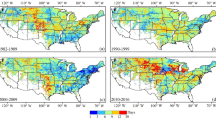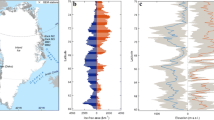Abstract
Land surface phenology has been widely used to evaluate the effects of climate change on terrestrial ecosystems in recent decades. Climate warming on the Tibetan Plateau (1960–2010, 0.2 °C/decade) has been found to be greater than the global average (1951–2012, 0.12 °C/decade), which has had a significant impact on the timing of spring greenup. However, the magnitude and direction of change in spring phenology and its response to warming temperature and precipitation are currently under scientific debate. In an attempt to explore this issue further, we detected the onset of greenup based on the time series of daily two-band enhanced vegetation index (EVI2) from the advanced very high resolution radiometer (AVHRR) long-term data record (LTDR; 1982–1999) and Moderate Resolution Imaging Spectroradiometer (MODIS) Climate Modeling Grid (CMG; 2000–2013) using hybrid piecewise logistic models. Further, we examined the temporal trend in greenup onset in both individual pixels and ecoregions across the entire Tibetan Plateau over the following periods: 1982–1999, 2000–2013, and 1982–2013. The interannual variation in greenup onset was linked to the mean temperature and cumulative precipitation in the preceding month, and total precipitation during winter and spring, respectively. Finally, we investigated the relationship between interannual variation in greenup onset dates and temperature and precipitation from 1982 to 2013 at different elevational zones for different ecoregions. The results revealed no significant trend in the onset of greenup from 1982 to 2013 in more than 86 % of the Tibetan Plateau. For each study period, statistically significant earlier greenup trends were observed mainly in the eastern meadow regions while later greenup trends mainly occurred in the southwestern steppe and meadow regions both with areal coverage of less than 8 %. Although spring phenology was negatively correlated with spring temperature and precipitation in the majority of pixels (>60 %), only 15 % and 10 % of these correlations were significant (P < 0.1), respectively. Climate variables had varying effects on the ecoregions with altitude. In the meadow ecoregion, greenup onset was significantly affected by both temperature and precipitation from 3500 to 4000 m altitude and by temperature alone from 4000 to 4500 m. In contrast, greenup onset across all elevational zones, in the steppe ecoregion, was not directly driven by either spring temperature or precipitation, which was likely impacted by soil moisture associated with warming temperature. These findings highlight the complex impacts of climate change on spring phenology in the Tibetan Plateau.








Similar content being viewed by others
References
Carlson TN, Ripley DA (1997) On the relation between NDVI, fractional vegetation cover, and leaf area index. Remote Sens Environ 62:241–252
Chen J, Jonsson P, Tamura M, et al. (2004) A simple method for reconstructing a high-quality NDVI time-series data set based on the Savitzky-Golay filter. Remote Sens Environ 91:332–344
Chen X, An S, Inouye DW, et al. (2015) Temperature and snowfall trigger alpine vegetation green-up on the world’s roof. Glob Chang Biol. doi:10.1111/gcb.12954
Cleland EE, Chuine I, Menzel A, et al. (2007) Shifting plant phenology in response to global change. Trends Ecol Evol 22:357–365
de Beurs KM, Henebry GM (2004) Land surface phenology, climatic variation, and institutional change: analyzing agricultural land cover change in Kazakhstan. Remote Sens Environ 89:497–509
de Beurs KM, Henebry GM (2005) Land surface phenology and temperature variation in the International Geosphere–Biosphere Program high-latitude transects. Glob Chang Biol 11:779–790
de Beurs KM, Henebry GM (2010) Spatio-temporal statistical methods for modelling land surface phenology. In: Hudson IL, Keatley MR (eds) Phenological research. Springer, Netherlands, pp. 177–208
Donnelly A, Yu R, Liu L (2015) Trophic level responses differ as climate warms in Ireland. Int J Biometeorol 59:1007–1017
Farr TG, Rosen PA, Caro E, et al. (2007) The shuttle radar topography mission. Rev Geophys 45:RG2004
Friedl MA, Gray JM, Melaas EK, et al. (2014) A tale of two springs: using recent climate anomalies to characterize the sensitivity of temperate forest phenology to climate change. Environ Res Lett 9:054006
Ganguly S, Friedl MA, Tan B, et al. (2010) Land surface phenology from MODIS: characterization of the Collection 5 global land cover dynamics product. Remote Sens Environ 114:1805–1816
Goyal RK (2004) Sensitivity of evapotranspiration to global warming: a case study of arid zone of Rajasthan (India). Agr Water Manage 69:1–11
Holben BN (1986) Characteristics of maximum-value composite images from temporal AVHRR data. Int J Remote Sens 7:1417–1434
Huete A, Didan K, Miura T, et al. (2002) Overview of the radiometric and biophysical performance of the MODIS vegetation indices. Remote Sens Environ 83:195–213
Jiang Z, Huete AR, Didan K, et al. (2008) Development of a two-band enhanced vegetation index without a blue band. Remote Sens Environ 112:3833–3845
Jönsson P, Eklundh L (2002) Seasonality extraction by function fitting to time-series of satellite sensor data. IEEE Trans Geosci Remote Sens 40:1824–1832
Justice CO, Vermote E, Townshend JR, et al. (1998) The Moderate Resolution Imaging Spectroradiometer (MODIS): land remote sensing for global change research. IEEE Trans Geosci Remote Sens 36:1228–1249
Kim Y, Huete AR, Miura T, et al. (2010) Spectral compatibility of vegetation indices across sensors: band decomposition analysis with Hyperion data. J Appl Remote Sens 4:043520
Lieth H (1974) Phenology and seasonality modeling. Springer, Heidelberg
Liu L, Liu L, Hu Y (2012) Response of spring phenology to climate change across Tibetan Plateau. Remote Sensing, Environment and Transportation Engineering (RSETE), 2012 2nd International Conference on. IEEE, pp 1–4
Liu L, Liu L, Liang L, et al. (2014) Effects of elevation on spring phenological sensitivity to temperature in Tibetan Plateau grasslands. Chin Sci Bull 59:4856–4863
Liu L, Liang L, Schwartz MD, et al. (2015) Evaluating the potential of MODIS satellite data to track temporal dynamics of autumn phenology in a temperate mixed forest. Remote Sens Environ 160:156–165
Menzel A, Sparks T, Estrella N, et al. (2006) European phenological response to climate change matches the warming pattern. Glob Chang Biol 12:1969–1976
Moody A, Johnson D (2001) Land-surface phenologies from AVHRR using the discrete Fourier transform. Remote Sens Environ 75:305–323
Moulin S, Kergoat L, Viovy N, et al. (1997) Global-scale assessment of vegetation phenology using NOAA/AVHRR satellite measurements. J Clim 10:1154–1170
Myneni RB, Tucker CJ, Asrar G, et al. (1998) Interannual variations in satellite-sensed vegetation index data from 1981 to 1991. J Geophys Res 103:6145–6160
Pedelty J, Devadiga S, Masuoka E et al (2007) Generating a long-term land data record from the AVHRR and MODIS Instruments. Geoscience and Remote Sensing Symposium, 2007. IGARSS 2007. IEEE International, Barcelona. IEEE
Peng S, Piao S, Ciais P, Fang J, Wang X (2010) Change in winter snow depth and its impacts on vegetation in China. Glob Chang Biol 16:3004–3013
Piao S, Cui M, Chen A, et al. (2011) Altitude and temperature dependence of change in the spring vegetation green-up date from 1982 to 2006 in the Qinghai-Xizang Plateau. Agric For Meteorol 151:1599–1608
Schwartz MD (2003) Phenology: an integrative environmental science. Springer, Netherlands
Shen M (2011) Spring phenology was not consistently related to winter warming on the Tibetan Plateau. Proc Natl Acad Sci 108:E91–E92
Shen M, Sun Z, Wang S, et al. (2013) No evidence of continuously advanced green-up dates in the Tibetan Plateau over the last decade. Proc Natl Acad Sci U S A 110:E2329–E2329
Shen M, Zhang G, Cong N, et al. (2014) Increasing altitudinal gradient of spring vegetation phenology during the last decade on the Qinghai–Tibetan Plateau. Agric For Meteorol 189–190:71–80
Shen M, Piao S, Cong N, Zhang G, Jassens IA (2015) Precipitation impacts on vegetation spring phenology on the Tibetan Plateau. Glob Chang Biol 21:3647–3656
Sparks TH, Menzel A (2002) Observed changes in seasons: an overview. Int J Climatol 22:1715–1725
Sparks T, Tryjanowski P (2005) The detection of climate impacts: some methodological considerations. Int J Climatol 25:271–277
Tsend-Ayush J, Miura T, Didan K, et al. (2012) Compatibility analysis of SPOT-4 vegetation and terra modis vegetation index products for long-term data records. IEEE international geoscience and remote sensing symposium. Munich, Gernamy
Virtanen R, Luoto M, Rämä T, et al. (2010) Recent vegetation changes at the high-latitude tree line ecotone are controlled by geomorphological disturbance, productivity and diversity. Glob Ecol Biogeogr 19:810–821
Wang T, Peng S, Lin X, Chang J (2013) Declining snow cover may affect spring phenological trend on the Tibetan Plateau. Proc Natl Acad Sci U S A 110:E2854–E2855
White MA, de Beurs KM, Didan K, et al. (2009) Intercomparison, interpretation, and assessment of spring phenology in North America estimated from remote sensing for 1982-2006. Glob Chang Biol 15:2335–2359
Wu X, Liu H (2013) Consistent shifts in spring vegetation green-up date across temperate biomes in China, 1982–2006. Glob Chang Biol 19:870–880
Wu Q, Zhang T (2010) Changes in active layer thickness over the Qinghai-Tibetan Plateau from 1995 to 2007. J Geophys Res 115:D09107
Xu W, Liu X (2007) Response of vegetation in the Qinghai-Tibet Plateau to global warming. Chin Geogr Sci 17:151–159
Yu H, Luedeling E, Xu J (2010) Winter and spring warming result in delayed spring phenology on the Tibetan Plateau. Proc Natl Acad Sci U S A 107:22151–22156
Yu H, Xu J, Okuto E, et al. (2012) Seasonal response of grasslands to climate change on the Tibetan Plateau. PLoS One 7:e49230
Zhang B, Wu Y, Lei L, Li J, Liu L, Chen D, Wang J (2013) Monitoring changes of snow cover, lake and vegetation phenology in Nam Co Lake Basin (Tibetan Plateau) using remote sensing (2000–2009). J Great Lakes Res 39:224–233
Zhang G, Zhang Y, Dong J, et al. (2013) Green-up dates in the Tibetan Plateau have continuously advanced from 1982 to 2011. Proc Natl Acad Sci U S A 110:4309–4314
Zhang X (2007) Vegetation map of the People’s Republic of China 1:1 000 000. The Geological Publishing House, Beijing
Zhang X (2015) Reconstruction of a complete global time series of daily vegetation index trajectory from long-term AVHRR data. Remote Sens Environ 156:457–472
Zhang X, Friedl MA, Schaaf CB, et al. (2003) Monitoring vegetation phenology using MODIS. Remote Sens Environ 84:471–475
Zhang X, Tan B, Yu Y (2014) Interannual variations and trends in global land surface phenology derived from enhanced vegetation index during 1982–2010. Int J Biometeorol: 1–18
Zhang X, Tarpley D, Sullivan JT (2007) Diverse responses of vegetation phenology to a warming climate. Geophys Res Lett 34:L19405
Zhou H, Yao B, Xu W, Ye X, Fu J, Jin Y, Zhao X (2014) Field evidence for earlier leaf-out dates in alpine grassland on the eastern Tibetan Plateau from 1990 to 2006. Biol Lett 10:20140291
Acknowledgments
This work was supported by the NASA NNX15AB96A project and the NOAA JPSS Risk reduction program.
Author information
Authors and Affiliations
Corresponding author
Rights and permissions
About this article
Cite this article
Liu, L., Zhang, X., Donnelly, A. et al. Interannual variations in spring phenology and their response to climate change across the Tibetan Plateau from 1982 to 2013. Int J Biometeorol 60, 1563–1575 (2016). https://doi.org/10.1007/s00484-016-1147-6
Received:
Revised:
Accepted:
Published:
Issue Date:
DOI: https://doi.org/10.1007/s00484-016-1147-6




